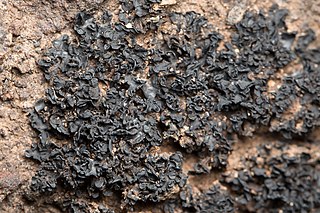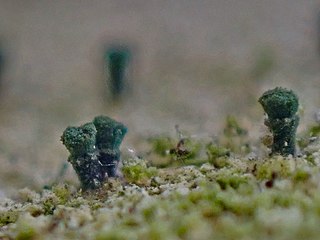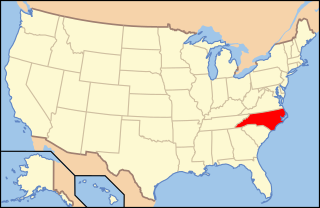
Gloeoheppiaceae is a family of ascomycete fungi in the order Lichinales. The family contains ten species distributed amongst three genera. Most species are lichenised with cyanobacteria. Species in this family are mostly found in desert areas. Modern molecular phylogenetics analysis casts doubt on the phylogenetic validity of the family, suggesting a more appropriate placement of its species in the family Lichinaceae.

The Lichinaceae are a family of ascomycete fungi. Most species are lichenized with cyanobacteria, and have a distribution largely in temperate regions.

The Gomphillaceae are a family of lichen-forming fungi in the order Graphidales. Species in this family are found mostly in tropical regions.

The Stictidaceae are a family of fungi in the order Ostropales. It has 30 genera and about 240 species.

The Icmadophilaceae are a family of lichen-forming fungi in the order Pertusariales. The family was circumscribed in 1993 by the mycologist Dagmar Treibel. It contains 9 genera and 35 species.

Microcalicium is a genus of lichen-forming fungi in the order Pertusariales. It is the only genus in the monotypic family Microcaliciaceae. These taxa were circumscribed by the Finnish lichenologist Edvard August Vainio in 1927, with Microcalicium disseminatum assigned as the type species.

Candelariaceae is a family of lichen-forming fungi in the order Candelariales. It contains seven genera and about 73 species.

The Lecideaceae are a family of lichens in the order Lecideales. It contains about 30 genera about roughly 250 species. A major distinguishing characteristic of the family is the lecanoroid form of the fruiting bodies: typically circular, dark, and without a thalline margin. Most species in the family are lichenised with green algae, although a few species, scattered amongst several genera, are lichenicolous–they live on other lichens. Lecideaceae lichens tend to grow on rocks, wood, and soil. The largest genus in the family, Lecidea, was once a loosely circumscribed wastebasket taxon containing hundreds of morphologically similar species with generally crustose thalli, photobiont-free apothecial margins and translucent, single-celled ascospores. The overall taxonomy and classification within the family has been made more accurate with recent molecular phylogenetics studies.

Paraphaeosphaeria pilleata is a species of fungus in the Lophiostomataceae family. The species fruits exclusively in the lower parts of the culms of the black needlerush. It is found on the Atlantic Coast of North Carolina.

The Tephromelataceae are a family of lichenized fungi in the order Lecanorales. The family was circumscribed by Austrian lichenologist Josef Hafellner in 1984. Tephromelataceae comprises the genera Tephromela, Calvitimela, Mycoblastus and Violella, which together constitute a well-supported monophyletic group.

Hertelidea is a genus of crustose lichens in the family Stereocaulaceae. Characteristics of the genus include carbon-black ring or outer margin (exciple) around the fruit body disc (apothecium), eight-spored, Micarea-type asci and mostly simple, hyaline ascospores that lack a transparent outer layer. Hertelidea species mostly grow on wood, although less frequently they are found on bark or soil. While the type species, Hertelidea botryosa, has a widespread distribution, most of the other species are found only in Australia.

Schaereria is a genus of lichen-forming fungi. It is the sole genus in the family Schaereriaceae, which itself is the only family in the Schaereriales, an order in the subclass Ostropomycetidae of the class Lecanoromycetes. Most Schaereria species are crustose lichens that live on rocks. Schaereria was first proposed by Gustav Wilhelm Körber in 1855 and was later taken up by other lichenologists despite periods of disuse.

Rhizocarpales are an order of lichen-forming fungi in the subclass Lecanoromycetidae of the class Lecanoromycetes. It has two families, Rhizocarpaceae and Sporastatiaceae, which contain mostly crustose lichens.

Carbonicola is a small genus of lichen-forming fungi. It is the sole genus in the monogeneric family Carbonicolaceae. The genus, which collectively has an almost cosmopolitan distribution, contains three squamulose lichens that prefer to grow on burned wood in temperate areas of the world.

Massalongiaceae is a small family of lichen-forming fungi in the order Peltigerales. It has three genera and seven species.
Architrypethelium hyalinum is a species of corticolous (bark-dwelling), crustose lichen in the family Trypetheliaceae. Found in Costa Rica and Brazil, it was formally described as a new species in 2008 by lichenologist André Aptroot. The type specimen was collected by Harrie Sipman from the Las Cruces Biological Station in Puntarenas. The lichen has a smooth to uneven, olive-green thallus. Its ascomata occur solitarily, have an apical ostiole, and measure 0.7–1.5 mm in diameter. Ascospores number 4 to 8 per ascus, have an oblong to ellipsoid shape with 3 septa, and measure 100–150 by 30–50 μm. These spores are among the largest of the 3-septate lichens in the Trypetheliaceae. Both the thallus and ascomata contain lichexanthone, a lichen product that causes these structures to glow yellow when lit with a long-wavelength UV light; A. hyalinum is the only species in genus Architrypethelium that contains lichexanthone.
Ostropomyces is a genus of fungi in the family Stictidaceae. It has two species, both of which are found in tropical forests in northern Thailand, where they grow as saprotrophs on bark.
Byssoloma fuscothallinum is a species of foliicolous (leaf-dwelling) lichen in the family Pilocarpaceae. Found in Colombia and French Guiana, it was formally described as a new species in 2006 by lichenologist Robert Lücking.
Enterographa aldabrensis is a species of corticolous (bark-dwelling), crustose lichen in the family Roccellaceae. It is only known to occur in Aldabra in the Seychelles.
The Pyrenotrichaceae are a small family of fungi in the order Chaetothyriales. It contains two genera, and a total of six species. The genus Pyrenothrix has two species of bark- or leaf-dwelling lichens, while Neophaeococcomyces has four species of saprobic fungi.














